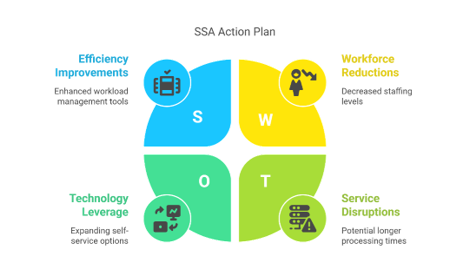
The Social Security Administration (SSA) introduced the 2024 Action Plan, which outlines significant changes to improve workload management, leverage automation, and streamline operational processes. With increasing demands and staffing reductions, SSA focuses on efficiency-driven solutions to enhance service delivery while optimizing internal resources.
Enhanced Workload Management Tools
To address the growing workload challenges, SSA is implementing new management tools designed to improve efficiency:
- Centralized Task Display: A unified system consolidating all pending tasks and requests for information in one location, reducing the need for employees to switch between applications.
- Automatic Case Assignment: The system will now automate case assignments while providing a full workload queue view, making prioritization more effective.
- Integration of Systems: Tools like the Workload Action Center (WAC) will enhance task portability across offices, ensuring smoother operations and better case management.
Leveraging Automation and AI
Technological advancements are at the core of SSA’s efficiency efforts:
- Automated Medicare Process (AMP): A new system that slashes Medicare claims processing time from 7 minutes to 7 seconds, freeing employees up for more critical tasks.
- AI-Supported Workflows: Artificial intelligence will assist with policy navigation, automated workflows, and interview scripts to reduce manual labor.
- IMAGEN Tool: This tool will aid in disability determinations by organizing evidence and streamlining documentation processes.
Process Simplifications
SSA is introducing straightforward process improvements to enhance operational flow:
- “No-to-All” Button: A simple fix that allows employees to process repetitive inputs faster, improving claims handling speed.
- Policy Unification: Reducing inconsistencies across policies to simplify tasks for employees and create a more cohesive system.
Training and Employee Support
Workforce efficiency is being reinforced through targeted training programs:
- On-the-Job Training (OJT) & Mentorship: Strengthened training programs will ensure employees are better equipped to handle their workloads efficiently.
- Improved Communication Tools: New feedback mechanisms will help employees understand priorities and reduce confusion.
Encouraging Self-Service Among Customers
To lighten employee workload, SSA is expanding self-service options:
- Increased Digital Submissions & Online Applications: The SSA aims to reduce the volume of routine inquiries employees handle by promoting online self-service tools.
Pilot Programs to Improve Efficiency
- “Adjudication Day” Pilot Program: Tested in 10 field offices, this initiative dedicates specific days to resolving backlogged cases, potentially increasing overall productivity.
Overview: Broader Changes Impacting SSA
Alongside these efficiency initiatives, SSA is undergoing operational restructuring, including workforce reductions, policy adjustments, and security enhancements. These shifts will impact both employees and beneficiaries, with key updates to monitor:
Workforce Reductions & Restructuring
- SSA plans to reduce its workforce by 12% (approximately 7,000 positions).
- The agency consolidates regional offices from 10 to 4, reducing management layers.
- Voluntary separation incentives are being offered, with the potential for layoffs or reassignments.
Implications
While these changes aim to streamline operations and enhance fiscal responsibility, they may also lead to:
- Longer processing times for claims and applications.
- Service disruptions impacting beneficiaries seeking assistance.
- Increased burden on remaining staff despite automation efforts.
Looking Ahead
SSA’s strategic initiatives focus on leveraging technology to improve service efficiency and manage workloads. However, with significant workforce reductions and restructuring, the long-term effects remain uncertain. Resource Corporation of America (RCA) will be monitoring SSA’s efforts to streamline both staff and operational workflows to assess their impact on overall cycle times and impacts on both the patients and facilities we serve.

Leave A Comment
You must be logged in to post a comment.